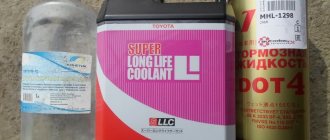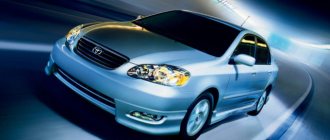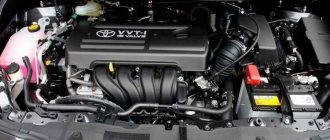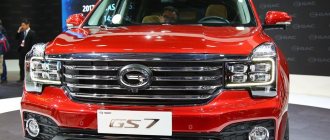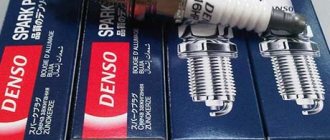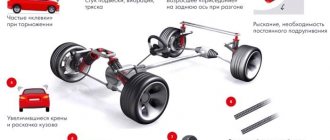Dimensions of different generations of Toyota Camry XV10-XV70
In the matter of choosing a “horse,” the dimensions, along with the weight of the vehicle, play an important role. Dimensions represent the maximum indicators of external outlines and collectively characterize the length, width and height. These parameters are taken into account by drivers when planning maneuvers, parking and changing lanes, and when passing through gates and arches.
Everyday situations such as driving on busy roads, avoiding potholes and obstacles, making U-turns and overtaking become difficult if the driver does not feel the size of his own car. The dimensions of the Toyota Camry vary depending on the specific models of the vehicle line.
Torque Wrench Selection
Toyota Camry 2006
The goals you pursue form the basis of the requirements for such tools. The financial aspect is also important. The most expensive will be a key with electronic filling, but if your goal is not to achieve high accuracy, then you can take a closer look at click or torsion models.
When deciding which torque wrench to choose, be sure to ensure the originality and integrity of the tool. There should be no visible defects on it. Choose models made of durable alloys and reliable mechanisms, then the key will last much longer. The choice of the range of expected efforts will be important. The instructions for the car will help you determine this, where the permissible parameter for the applied clamping forces is indicated for each threaded connection.
In short, base your purchase on what you will do with it. Before testing a torque wrench at home, you should test it in a store.
Don't forget to make sure how it fits in your hand. Comfort of use is very important, because you not only need to keep the instrument intact, but also not damage your palms.
The handle should fit your fingers perfectly. The surface must be selected from non-slip materials so that the hand does not jump off the key at the most inopportune moment. Also, you should not feel any strain on your wrist with prolonged use. And now when all the details are taken into account, you can start purchasing.
Dimensions of Camry XV10
Body parameters, namely width, height and length of the Toyota Camry XV10 are 1770, 1415 and 4725 mm, respectively. At the same time, the wheelbase is 2 m 61.8 cm, the distance between the front wheels is one and a half meters and 4.9 centimeters, and the rear is one and a half meters and 9.9 centimeters. Weight: 1355 kilograms. Aerodynamic drag coefficient: 0.31.
The XV10 has more modest parameters, discussed in this material, in comparison with models of subsequent generations, however, their differences are not so significant that one has to talk about better handling on the road or more comfortable parking.
What can you say about the appearance?
The first thing that catches your eye is the dimensions of the body: they have become noticeably larger. The car looks more impressive; its appearance and internal contents have changed significantly. The car became sporty, while remaining solid. It is perfect for business people who value style and comfort and want to emphasize their status. The elegance of the lines is emphasized by mirrors that fit well into the overall design.
The radius of the wheel arches is quite large and allows the installation of R17 wheels: large wheels make the car more aggressive, making it seem larger and more powerful. The style can be seen in absolutely everything: from the aggressive radiator grille with a large air intake to the tail section of the car, which attracts the attention of passers-by. Despite the heavy weight, the car does not look bulky, it creates a feeling of lightness, and controllability is also high. Toyota reacts to the slightest touch on the steering wheel, and driving it is not difficult.
The Camry, which is larger than average, easily changes from row to row, takes turns, and maneuvers in city traffic. This is not a clumsy sedan, but a nimble sports car in terms of dynamics.
Toyota Camry XV40
Overall dimensions of Toyota Camry XV40 (length-width-height): 481.5-182-148 centimeters. The length of the car, in comparison with the previous generation, has not changed at all; the car has become 3 centimeters wider and 2 centimeters lower.
- front track width – 157.5 cm;
- rear track width – 156.5 cm;
- wheelbase – 277.5 cm.
The car has a weight of 1450 kg and a permissible gross weight of 1985 kg. At the same time, the aerodynamic drag coefficient is the same as that of the previous generation: 0.28.
There is a separate material about clearance, you can read it here.
Sienna
The roomy Toyota Sienna minivan has been delighting car enthusiasts since 1997. Initially, the model was designed for the North American market. However, later many other countries expressed a desire to buy the same minivans.
With each new generation, the Sienna has only gotten bigger. In 2003, the developers introduced an all-wheel drive option. And for the USA, this version was the only one of its kind with all four driven wheels.
Assembly of the first generation began in August 1997 at the American plant in Georgetown. Back then it was a front-wheel drive minivan. The car is considered one of the safest due to the rigidity of the body and seat belts on all seats, without exception. In addition, there were two front airbags.
Even for contemporaries, the car inside seemed extremely roomy with three rows of seats. There were two seats behind the driver with space in the middle that allowed access to the third row. The latter looked like a solid sofa designed for 3 people. The trunk volume with the third row seats unfolded was almost one and a half cubic meters of usable space. When folding the seats, this space increased by another one and a half times.
When the minivan needed to be used to transport goods, all passenger seats were removed with the exception of the front one. This made it possible to increase the usable space to 4 cubic meters. The parameters were as follows: LxWxH - 4930/1865/1710 mm.
Under the hood was a 6-cylinder V-type power unit. Filled up with gasoline. The engine capacity was 3 liters and produced 194 liters. With. The installation incorporated DOHC technology, that is, each cylinder head had 2 camshafts. Together with the engine there was a 4-speed automatic transmission with a hydromechanical system.
In 2001, the front part of the car was updated with a new bumper. A variety of body colors were offered to choose from. The salon has become more comfortable and respectable. Several electronic assistants have appeared. During the existence of the first generation, more than half a million copies were produced.
In 2003, the second generation appeared. It was shown at the Detroit Auto Show. The variation lasted 6 years. Due to the high demand for the model, a second Toyota Sienna production line was opened in Princeton.
The new product turned out to be much larger than its predecessor. The body became streamlined, the rear doors still remained sliding. True, here the runners were already removed under the windows. By increasing the wheel track, it was possible to increase the space in the cabin. The steel dimensions are as follows: LxWxH – 5105/1965/1750 mm.
At the discretion of the buyer, either two or three seats were installed in the second row. This made it possible to accommodate 7 or 8 people in the cabin, respectively.
There are a lot of new things inside. Convenient ergonomic details for the driver have been added. Many electronic functions have appeared, such as:
- adaptive cruise control system;
- advanced multimedia;
- multifunction steering wheel;
- DVD player with folding screen for rear passengers;
- electrified rear door opening mechanisms;
- electric windows;
- drive for opening and closing the trunk door;
- electronic stability control system;
- Brake Load Distribution (EBD);
- ABS, BAS;
- traction control system;
- climate control.
Under the hood, the second-generation models had a traditional 3.3-liter V-twin gasoline engine. Produced 230 l. With. It was paired with an automatic gearbox with a hydromechanical control system. In addition to front-wheel drive, there is also an option with all-wheel drive.
In mid-2005, the Toyota Sienna underwent an update. The new product also has a new front bumper, radiator grille, headlights and taillights. On top modifications, many electronic functions have appeared that increase ease of use.
A new variation of the 3.5-liter engine with 266 hp has been produced. With.
The third and so far the last generation appeared at the beginning of 2010. This generation is still being produced to this day. The Sienna parameters are as follows: LxWxH – 5086/1985/1811 mm.
The wheelbase remained from the previous generation, but the minivan became wider and shorter. The body shape has acquired sporty notes. They were distinguished by sculpted headlights mounted slightly higher than usual. The engineers even worked on the bottom, so the car has excellent aerodynamic characteristics.
There are seven airbags in the cabin. For the first time, driver knee airbags were added, as well as curtains on the sides of the body.
Under the hood was the same 3.5-liter power unit producing 266 hp. With. But you can also choose a 2.7-liter 4-cylinder engine, designed for 187 horsepower. Both power plants have the latest valve control systems.
Camry XV50
Dimensions or dimensions of Camry XV50:
- length – 485 cm;
- width 182.5 cm;
- height – 148 cm.
The chassis is characterized by the following indicators:
- front track width – 1575;
- rear track width – 1565;
- wheelbase - 2775.
The model has the same rear overhang as the XV40, and the front overhang is 5 more. The XV50 weighs 1 ton 540 kilograms. Interior dimensions: 208 cm length, 152.5 cm width and 121 cm height.
Read more about the ground clearance of the Japanese sedan here.
Scoring
Impressions from meeting the new Mercedes compact van were expressed in quantitative assessments. Take a look:
Appearance
– 4 points (out of 5 possible). The B-Class II looks quite attractive for a single-volume car. True, due to the sloping hood (a requirement for pedestrian safety), the car looks, so to speak, “big-nosed”; nevertheless "good".
Road holding and handling
– 4. The “station wagon” looks quite decent in high-speed maneuvering. The steering wheel is “transparent”, and handling does not cause any complaints. "Fine".
Dynamics
– 3. Gasoline engines and turbodiesels pull well, but you can’t expect outstanding throttle response from a “station wagon.” "Satisfactorily".
Comfort and equipment
– 4. On second-rate roads, the B-Class II, unfortunately, does not go as smoothly as you would expect from a Mercedes model. “Standard” comfort and entertainment equipment is no frills, but the list of paid options is endless. "Fine".
Security and Protection
– 5. There are no doubts about the “active” and “passive” safety of the new B-class. The Mercedes station wagon is expected to show high results in impact tests using the EuroNCAP method. Without looking - “excellent.”
The new 16-valve M270 works with direct injection of gasoline into the combustion chambers and is equipped with turbocharging.
Quality and reliability
– 4. Mercedes models have a (sometimes exaggerated) reputation, and the new B-Class is no exception. The execution and assembly of the car is up to par, although the quality of the interior finishing is uneven. Overall "good".
Inner space
– 4. Four adults can comfortably fit in the B-Class II cabin, but the fifth is not so comfortable. The large loading space is flexible; "Fine.
The “robotic” 7-speed 7G DCT gearbox did not leave the best impressions.
Operating costs
– 3. The new B-class is quite fuel efficient - especially with a turbodiesel. The price of the car is high, and the maintenance and repair costs are hardly small. Only "satisfactory".
On the plus side:
spacious interior and spacious luggage compartment; powerful and economical engines; correct handling balance; brand image.
Downside:
hard ride; uneven quality of interior finishing; noise in the cabin from rolling tires; high price.
Overall rating
– 3 points (out of 5 possible). The new B-Class is suitable for those who need a multi-purpose “family” car from the most prestigious brand. Whereas the price of the product is the tenth thing.
Verdict:
satisfactorily. A proper compact van, but not up to the true Mercedes class.
In Europe, for a new B-class they ask from 26 thousand 100 euros, and a “packed” B200 with a 156-horsepower engine and 7G DCT automatic transmission costs at least 30.75 thousand. How much will a Mercedes station wagon cost in our country? scary to think...
Purely specific.
The B-Class II is built on a new Mercedes platform, and the technology of the new compact van is advanced. The “line” of engines so far includes only two units: firstly, the 16-valve M270 with a displacement of 1595 milliliters. The all-aluminum “four” works with direct injection of gasoline into the combustion chambers and is equipped with turbocharging (intermediate cooling of the charged air). The compression ratio is 10, and there are adjustment options depending on the boost pressure. So, in a moderate version, the 16-valve engine produces up to 122 hp. at 5 thousand revolutions, maximum torque – 200 Nm. While the “charged” M270 develops up to 156 horsepower at 5300 min-1, the highest torque is 250 Nm.
Both engines are equipped with a Stop & Start device, which turns it off whenever the car stops, the gearbox is in neutral, and the driver takes his foot off the clutch pedal. In accordance with the BlueEFFICIENCY corporate philosophy, aimed at comprehensive fuel economy and reduction of harmful emissions. Secondly, the 1.8-liter OM651/D18 turbodiesel with a displacement of 1796 cubic meters is also available in two settings. In a weaker version, the engine develops up to 109 hp. at 3800 min-1, maximum torque – 250 Nm. And the powerful one produces up to 136 forces at the same 3800 min-1, the highest torque is 300 Nm. Petrol and diesel engines are mated to a 6-speed manual gearbox - or a 7-speed 7G DCT robotic gearbox (2 clutches, shifting without interrupting the power flow). Advanced power units - compared to the first generation.
The chassis of the new B-class is also significantly different from the first generation: if the front has the same McPherson struts, then the rear has a kinematically perfect suspension on double wishbones. Unlike the previous model, the rear suspension of which was distinguished by a continuous axle with a so-called “drawbar”. Apparently, the experiments have been completed, and now the B-class chassis is like all Mercs. Coil springs, transverse stabilizers - nothing special. Tires size 205/55R are mounted on 16-inch alloy wheels, and tires up to 225/40R18 are available for an additional fee. The rack and pinion steering mechanism is powered by electric power steering, and the disc brakes (ventilated at the front) are equipped with ABS and ESC. A complete set.
The curb weight of the B-class with a petrol M270 is from 1320 kg, with a turbodiesel – from 1400 kg. With a 122-horsepower 16-valve gasoline engine and a manual transmission, the compact van can accelerate from zero to 100 km/h in 10.4 seconds. The declared maximum speed is 190 km/h, and it consumes on average (EU5) less than 6 liters of gasoline per 100 km. With a 156-horsepower engine, the acceleration time to “hundreds” improves to 8.6 seconds, the maximum speed is 220 km/h. While the average gasoline consumption does not increase: the same 5.9 liters per 100 km. With a powerful turbodiesel and a manual transmission, the Mercedes station wagon reaches a hundred in 9.5 seconds, and consumes an average of only 4.4 liters of heavy fuel per 100 km. Maximum speed – 210 km/h; European favorite.
Point of view.
Do you want a new car – and certainly with a 3-pointed star on its forehead? But the budget doesn’t stretch for a Mercedes C-Class... Well, there is a non-standard solution: the Mercedes B-Class of the second generation. A roomy, comfortable and extremely safe station wagon. Although it is worth remembering that the Ford C-Max, for example, is much cheaper - and no weaker. And in some ways even stronger...
Camry XV70
Camry XV70 body dimensions: 4885-1840-1455 mm. Thus, we can conclude that the length and width of the Toyota Camry increases with each subsequent generation of the line, in contrast to the height.
The chassis remains virtually unchanged compared to the XV50, with the exception of the increased wheelbase – 282.5 centimeters. The XV70 has a weight of 1570 kg and a maximum permissible weight of 2030 kg.
The latest generations are equipped with front and rear parking sensors, with the help of which the driver feels comfortable when parking and learns the dimensions more effectively.
Alphard
The Toyota Alphard minivan is preferred by everyone who needs a minibus. According to statistics, they first look at Alphard, and then select them according to their capabilities and needs.
The minibus is versatile and extremely productive. Suitable for daily trips, transporting passengers or cargo, and as an office on wheels for dignitaries.
There are 3 generations. Began production in 2002. The configuration includes two types of engines – 2.4 and 3 liters. It officially appeared on the territory of the Russian Federation for the first time in 2011, but in a single configuration with a 3.5-liter power unit (2GR-FE). Dimensions: LxWxH – 4915/1850/1895 mm.
The value of dimensions during operation
The larger the car, the more difficult it is to drive, the more clumsy it behaves on the road and has difficulties with parking issues, however, as the size increases, the level of safe operation increases. When any situation arises on the road, the driver must have a great sense of the scale of the “horse” in order to promptly avoid an emergency situation, confidently and quickly occupy a parking space, and skillfully drive the vehicle in traffic jams.
For novice car enthusiasts, the most effective way to feel the scale is regular practice and the ability to correctly use information from the side mirrors. In particular, the importance of side mirrors cannot be overestimated when parking in reverse. Driving schools practice special exercises, the completion of which allows the car enthusiast to feel the size of the car much more effectively and feel more confident on the road in the most difficult situations.
Difficulties with feeling the size of their “horse” are often experienced not only by novice drivers, but also by experienced car owners when purchasing a new car, especially when changing the type, for example, from a sedan to an SUV or minivan.
Streamlining or drag directly affects not only speed, but also fuel consumption, stability and operational safety. The drag coefficient is determined by the manufacturer in a special wind tunnel or using computer simulation.
Source of the article: https://toyota-camry-corolla.ru/camry/gabarity-raznyh-pokolenij-tojota-kamri-xv10-xv70/
Toyota Century Royal
The impressive Century Royal business sedan is not only one of the largest cars, but also the most luxurious in the brand. The sedan is almost the official car of the Japanese imperial court. It was made specifically for the government.
The latest version of the model meets all the requirements of a modern premium car. A large screen in the middle of the center panel, multi-level climate control and many other electronic assistants and multimedia functions that increase the level of comfort on the road to the maximum.
The wheels are powered by a 5.0-liter V12 engine rated at 280 horsepower.
Tire and wheel sizes for Toyota Corolla (E110) 8, (E120, E130) 9, (E150) 10, (E180) 11, (E210) 12
Additional Information
- Drilling (PCD):
- Reach (ET): 45 - 45 mm
- Center Hole Diameter (DIA): 54.1mm
- Fastening to the hub: Nut
- Thread: M12 x 1.5
- Size
- Load Index
- Speed index
- Pressure
- Size
- Departure
- Sverlovka
I4, Diesel, 1.4 D 89 hp
175/70R14
- 84
- H
- 2.2
- 5.5Jx14
- ET45
- —
I4, Petrol, 1.4 VVT-i 95 hp
175/70R14
- 84
- H
- 2.2
- 5.5Jx14
- ET45
- —
195/65R15
- 91
- H
- 2.2
- 6Jx15
- ET39
- —
I4, Petrol, 1.6 VVT-i 109 hp
175/70R14
- 84
- H
- 2.2
- 5.5Jx14
- ET45
- —
I4, Petrol, 1.8 VVT-i 134 hp
175/70R14
- 84
- H
- 2.2
- 5.5Jx14
- ET45
- —
I4, Gasoline, 1.8 VVTL-i 189 hp
175/70R14
- 84
- H
- 2.2
- 5.5Jx14
- ET45
- —
I4, Petrol, 1.8 VVTL-i TS 221 hp
175/70R14
- 84
- H
- 2.2
- 5.5Jx14
- ET45
- —
I4, Diesel, 2.0 D-4D 114 hp
175/70R14
- 84
- H
- 2.2
- 5.5Jx14
- ET45
- —
Replacement options
195/60R15
- 88
- V
- 2.2
- 6Jx15
- ET45
- —
195/55R16
87
V
2.3 / 2.2
- 6Jx16
- ET45
- —
205/55R16
- 91
- V
- 2.2
- 6Jx16
- ET45
- —
215/40R17
- —
- —
- —
- 7.5Jx17
- ET40
- —
215/45R17
- 87
- W
- 2.2
- 7Jx17
- ET45
- —
225/45R17
- 93
- V
- 2.2
- 7Jx17
- ET39
- —
Salon
The interior of the car is distinguished by high-quality finishing, for which high-quality and expensive materials are used. In budget versions it is premium fabric, in top versions it is genuine leather. The front seats are heated and adjustable. Three passengers can comfortably fit in the back row - although tall people may find the cabin too low. The sedan also has 2 complete sets of latches for installing child car seats.
Among the features of the cabin is the presence of a multimedia entertainment system with a 7-inch screen, even as standard. There is support for Android Auto, Apple CarPlay and Siri Eyes Free, Wi-Fi and radio. And the top versions have a screen diagonal of 8 inches, the number of USB connectors increases by 2, and the audio system already has 9 speakers.
Purple antifreeze(G13)
A liquid of this class appeared in 2012 and is widely used among motorists. The compositions have a high boiling point, which attracts many buyers.
The composition is based on propylene glycol, which is absolutely harmless in the production and use of such liquids.
The key advantage is a huge service life, almost endless. Its structure is designed in such a way that it is practically not consumed. But, it will be most effective only when poured into a new internal combustion engine.
The only thing that puts me off is its cost, which can be several times higher than red (G12) antifreeze. But, it is easily covered by the service life and its effectiveness.

